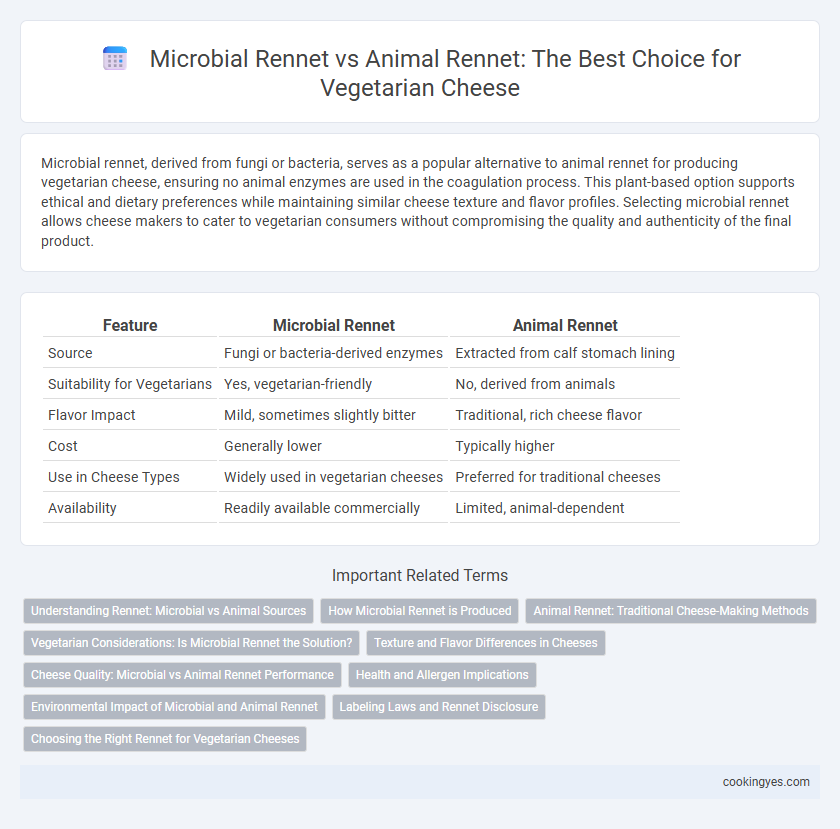Microbial rennet, derived from fungi or bacteria, serves as a popular alternative to animal rennet for producing vegetarian cheese, ensuring no animal enzymes are used in the coagulation process. This plant-based option supports ethical and dietary preferences while maintaining similar cheese texture and flavor profiles. Selecting microbial rennet allows cheese makers to cater to vegetarian consumers without compromising the quality and authenticity of the final product.
Table of Comparison
| Feature | Microbial Rennet | Animal Rennet |
|---|---|---|
| Source | Fungi or bacteria-derived enzymes | Extracted from calf stomach lining |
| Suitability for Vegetarians | Yes, vegetarian-friendly | No, derived from animals |
| Flavor Impact | Mild, sometimes slightly bitter | Traditional, rich cheese flavor |
| Cost | Generally lower | Typically higher |
| Use in Cheese Types | Widely used in vegetarian cheeses | Preferred for traditional cheeses |
| Availability | Readily available commercially | Limited, animal-dependent |
Understanding Rennet: Microbial vs Animal Sources
Microbial rennet is derived from fungi or bacteria and offers a vegetarian-friendly alternative to traditional animal rennet, which is extracted from the stomach lining of calves. This plant-based rennet effectively coagulates milk to form curds in cheese production without involving animal slaughter. Choosing microbial rennet ensures cheese products cater to vegetarians while maintaining similar texture and flavor profiles as those made with animal rennet.
How Microbial Rennet is Produced
Microbial rennet is produced through fermentation using genetically modified fungi, bacteria, or yeast strains that secrete chymosin, the key enzyme for coagulating milk proteins. This process ensures a consistent and scalable supply of rennet without relying on animal sources, making it suitable for vegetarian cheese production. Compared to animal rennet, microbial rennet offers ethical advantages and supports sustainable cheese manufacturing practices.
Animal Rennet: Traditional Cheese-Making Methods
Animal rennet, derived from the stomach lining of young calves, plays a crucial role in traditional cheese-making by coagulating milk and developing characteristic textures and flavors. This natural enzyme blend initiates protein breakdown, contributing to the complex aging process that defines many classic cheeses like Parmigiano-Reggiano and Roquefort. Despite its culinary significance, animal rennet is unsuitable for vegetarian cheese production, prompting the use of microbial rennet alternatives that mimic its coagulating properties without animal involvement.
Vegetarian Considerations: Is Microbial Rennet the Solution?
Microbial rennet, derived from fungi or bacteria, offers a vegetarian-friendly alternative to traditional animal rennet extracted from calf stomachs, addressing ethical concerns for vegetarians. This enzyme effectively coagulates milk in cheese production without compromising flavor or texture, making it widely accepted in vegetarian cheese varieties. With increasing demand for plant-based and vegetarian products, microbial rennet serves as a sustainable and cruelty-free solution in artisanal and industrial cheese manufacturing.
Texture and Flavor Differences in Cheeses
Microbial rennet produces cheese with a slightly different texture, often resulting in a firmer and sometimes grainier curd compared to the smoother, creamier texture achieved with animal rennet. Flavor profiles also diverge; microbial rennet can impart subtle bitter notes or sharpness, whereas animal rennet typically contributes to a rich, traditional taste complexity favored in aged cheeses. Selecting microbial rennet is ideal for vegetarian cheese production without compromising fundamental cheese characteristics, though subtle sensory differences remain detectable to connoisseurs.
Cheese Quality: Microbial vs Animal Rennet Performance
Microbial rennet and animal rennet both play critical roles in cheese production, but they differ significantly in enzyme composition, affecting cheese texture and flavor development. Microbial rennet often produces a slightly bitter taste and less smooth texture compared to animal rennet, which provides a more consistent coagulation and richer flavor profile due to its chymosin content. The choice between microbial and animal rennet impacts the aging process and final cheese quality, with animal rennet typically favored for traditional cheeses requiring precise maturation.
Health and Allergen Implications
Microbial rennet, derived from fungi or bacteria, provides a vegetarian-friendly alternative to animal rennet, which is sourced from calf stomach lining and may raise ethical and allergen concerns. Health implications of microbial rennet are minimal, with lower risks of transmitting animal pathogens and allergens compared to animal rennet, which can sometimes trigger allergic reactions in sensitive individuals. Using microbial rennet supports the production of cheese suitable for vegetarians while reducing potential exposure to animal-borne contaminants and allergens.
Environmental Impact of Microbial and Animal Rennet
Microbial rennet, derived from fungi or bacteria, offers a more sustainable alternative to animal rennet by significantly reducing greenhouse gas emissions and resource consumption associated with livestock farming. Animal rennet, sourced from the stomach lining of calves, contributes to environmental concerns including deforestation, methane emissions, and higher water usage. Selecting microbial rennet supports environmentally friendly cheese production while maintaining vegetarian standards.
Labeling Laws and Rennet Disclosure
Microbial rennet, derived from fungi or bacteria, is increasingly favored in vegetarian cheese production due to strict labeling laws that require clear disclosure of animal-derived ingredients. Animal rennet, sourced from calf stomachs, mandates explicit labeling to inform consumers about non-vegetarian contents, impacting product marketability. Regulations such as the FDA's rennet disclosure guidelines ensure transparent labeling to help vegetarians make informed choices between microbial and animal rennet cheeses.
Choosing the Right Rennet for Vegetarian Cheeses
Microbial rennet, derived from fungi or bacteria, offers a vegetarian-friendly alternative to traditional animal rennet obtained from the stomach lining of calves. It provides comparable coagulation efficiency and flavor development while ensuring that the cheese remains free of animal-derived ingredients. Selecting microbial rennet aligns with vegetarian dietary preferences without compromising the texture or quality of the cheese.
Microbial Rennet vs Animal Rennet for Vegetarian Cheese Infographic

 cookingyes.com
cookingyes.com